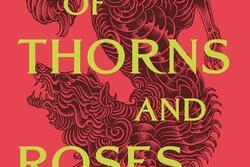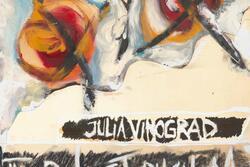A Jewish Narnia Comes Alive in "The Moonstone Covenant"
Set in an archipelago, a land of boats and bridges, Moonstone, the backdrop for Jill Hammer's debut novel, is a nation so devoted to books and knowledge, it’s like a university that morphed into a city-state. As its national focus on books alone might suggest, this is a kind of Jewish Narnia.
And it’s an unusually good iteration of the fantasy adventure novel. The world-building is flawless, with elaborate, enchanting fancies on the Borges end of the spectrum. There are “cloaksmen” who act as bodyguards for Moonstone’s princelings; inkwells shaped like castles, a different color in each turret with a roof that unscrews; bridges with shops and shrines tucked under their arches; gondolas whose headlights are a single lamp hanging from their steeply curved prows; houses with “pillow nests” by the hearth, isles “where sea-sheep graze peacefully on wide beaches and in the shallows, munching riverweed,” hot-air balloons, “pointed roofs, silver scaled like fish..." The architecture of Moonstone is as cozy and poetically quaint as an Art Nouveau spiral staircase.
At the center of the story are four female friends with special abilities, of whom the most intriguing is Istehar, of the Sha’an, a people with a dryad-like mystical affinity to trees, and to the books whose pages are made from them.
Istehar’s people, who symbolize the Jews, have been driven from their forest homeland by a hostile nation and find precarious refuge in urban Moonstone. Their religion, barely tolerated there, is thought to verge on sorcery, and its practitioners are called “witches” as a term of abuse.
The other characters are Annlynn, a tough-talking sword-wielding warrior librarian; Olloise, a science-minded woman who follows her father’s profession of forensic apothecary; and Vasmine, a courtesan turned ink-merchant. The four friends can be interpreted as aspects of the author’s own personality, an excellent trope, and one that affords the reflective reader a hologram portrait of the author.
A well-realized detective story set in a political drama, the book exceeds expectations with its taut plot and splendid writing. The multiple actors and complex actions are clearly defined, so one never has to puzzle over who’s who or why something happens when it does. An unusual feat for a first novel!
The only clue that this is a first effort is perhaps the very correctness of its structures. From the map and cast of characters in the front to the notes on the history and sociology of the various peoples in the appendix, and everything in between, The Moonstone Covenant is scrupulously genre-correct.
This is a female-centered novel of the sort that has been in the repertory since Marion Zimmer Bradley’s Mists of Avalon. The women characters are all powerful and fascinating; the male ones, for the most part, malicious or marginal.
The feminist mono-gender adventure genre arose as a symmetrical reply to the stories for boys pioneered by Rudyard Kipling and Robert Louis Stevenson. Those all-boy adventure yarns were a (what else?) puerile literary response to the “new woman” and the suffragettes. It was a rear-guard action from a masculinity that perceived itself as embattled—and one with (via Stevenson) a homophile subtext.
It is then well within the tradition that this girl-power ripping yarn is also a lesbian novel. The four female friends at its center are linked in a group marriage—placing their romantic quartet squarely in the now fashionable genre of gender-nonconforming fantasy romance. The erotic scenes are handled with understated good taste—unambiguous but not explicit. This gay relationship is accepted, with some distaste, by the society around them, and thus the theme of intolerance is addressed here with maturity and restraint—as it is with persecution of the Sha’an, which echoes that of the Jews.
Indeed, the most distinctive thing about this book is its Jewish subtext. Published by Ayin, the hippie contingent of the Jewish literary press, it has deeply Semitic religious resonances. One expects no less from Hammer, who founded Kohenet, an institute for the ordination of Hebrew Priestesses.
In her account of the Sha’an, the exiled, indigenous people of the wilderness north of Moonstone, Hammer’s fantasy takes the audacious step of mythologizing Jewish civilization itself. Their scriptures are the wisdom of nature itself, literally “leaves” of the Tree of Life.
The pages of the Sha’an’s "Bible" are seemingly blank: This reflects Hebrew writing, opaque and thus a “blank” to the gentile, a source of fear and suspicion to the Hebrews’ hosts in exile. There is also a suggestion that the book’s mysteries are ineffable, expressible only by silence. This is the austere and absolute Jewish formulation of Deity, beyond depiction—a God whose name is famously impossible to even utter. Here monotheism has been translated into the language of Fantasy!
Our world, which industry and science make less recognizable by the decade, necessitates a spiritual age of exploration. More valuable hints and leads may often be gleaned from poems and fantasy novels than from sermons or scholarly articles, and Hammer’s choice of genre fiction as the vehicle for her wisdom, cannot be too warmly applauded. She has not simply served up another helping of dybbuks, golems, and rabbis with magical powers, the warmed-up leftovers of Eastern European folklore. Instead she has excavated profound and structural Jewish archetypes. Archetypal forms are common in fantasy literature; for example, Jules Verne’s Journey to the Center of the Earth traces a classic labyrinth. But to use them with precision of purpose, infusing ancient symbols with new meaning—as Hammer has here with her Tree of Life whose leaves are pages veined with writing from no man’s hand—is a significant spiritual achievement.







